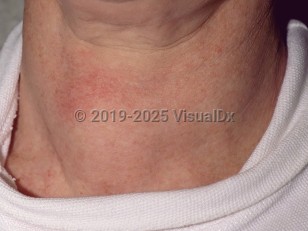Acute hypothyroidism may develop after thyroidectomy or withdrawal of thyroid hormone; these symptoms are often less well tolerated than when hypothyroidism develops gradually.
Hypothyroidism may be classified in the following ways:
- Primary hypothyroidism – Disease of the thyroid gland that leads to decreased production of thyroxine and triiodothyronine with compensatory increase in serum thyrotropin (TSH) levels. Primary hypothyroidism has many causes including Hashimoto thyroiditis, thyroidectomy, radioiodine therapy to treat Graves disease, and medications such as lithium, amiodarone, interferon-alpha, interleukin-2, and oral tyrosine kinase inhibitors.
- Secondary hypothyroidism – Caused by a TSH deficiency, often due to diseases of the pituitary such as pituitary tumor, postpartum pituitary necrosis, trauma, hypophysitis, infiltrating tumors, or nonpituitary tumors such as craniopharyngiomas. Patients will have inappropriately low or normal TSH values in the setting of suppressed thyroxine (T4) values.
- Tertiary hypothyroidism – A deficiency of thyrotropin-releasing hormone (TRH) due to disorders affecting the hypothalamus or interfering with HPA portal.
Rare but severe complications of hypothyroidism include heart failure and myxedema coma, which results in altered mental status, lethargy, bradycardia, hypothermia, multiple organ system failure, and ultimately death if left untreated.
Related topic: congenital hypothyroidism



